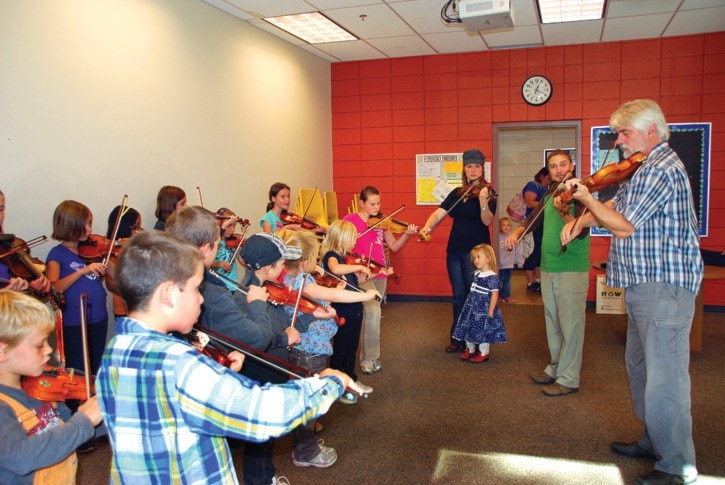Fiddle music has been building community across Canada since the first settlers arrived in the country.
And fiddle music is now doing its bit to build a greater sense of community in Williams Lake.
A fiddle workshop taking place in the lakecity this week with top Canadian fiddlers Gordon Stobbe from Halifax and J.J. Guy from Saskatoon will wrap up Saturday evening Sept. 15 with a community family dance at the 150 Mile House Fire Hall starting at 7 p.m. Admission is by donation.
Stobbe and Guy and lakecity violin/fiddle teacher Ingrid Johnston are instructing 34 students ages five to 18 in five days of workshop sessions this week designed to teach the students songs for a show about the history of fiddle music in Canada.
Many of the students who have learned the songs will join the instructors in performing at the dance that will include old time Canadian dances and music such as the Black Velvet Waltz, Heel Toe Polka, Schottisches, Fox Trots, and the Virginia Reel.
In efforts to raise awareness about fiddle music in Canada and give fiddle students a goal to strive for, Stobbe developed the Fiddle History of Canada show with input from other fiddlers such as Leslie-Jean MacMillan who leads the Smithers fiddle group that performed in Williams Lake this spring.
Stobbe says songs for the show trace the history of fiddle music in Canada starting in 1604/05 when the Acadians from France settled in Nova Scotia and created songs such as Evangeline which talks about their expulsion from Nova Scotia.
The show includes songs by Irish settlers in Newfoundland such as Sean Ryan’s Polka, Scottish settlers in Nova Scotia, Quebecois fiddle songs such as Reel de St. Antoine, Ottawa Valley/Ontario style songs such as the Old Red Barn and Chinese Breakdown, along with songs from the First Nations and Metis fiddle traditions such as chief Big Bear.
Songs with historical reference make up the first part of the show which the students are now learning.
The second half of the show, which may come later, traces the history of fiddle music since the early days of recordings by masters such as Don Messer, Rufus Guinchard, Emile Beloit and Graham Townsend.
The students are learning the songs all by ear, not by reading music, Stobbe says.
He says each song has parts for beginner, intermediate and advanced students.
In a fully developed show, there would be a narrator to talk about the history of each of the songs presented.
“In some ways the narrator is the star of the show,” Stobbe says.
As the show develops, Stobbe says there will be places for other musicians such as drummers, guitarists, and cello players. He says there should be at least two of the other musicians to spell each other off for performances.
While the local fiddlers may not have a narrator yet, Cariboo Chilcotin Youth Fiddle Society spokesperson Candice Magnowski says the songs the students learn will become part of future performances at community events held in the area.
Separate from their regular lessons, Magnowski says students participating in the program will work on the show songs once a month in their beginner, intermediate and advanced groups and once a month when all of the groups come together to practice.
Stobbe and Guy will also be back in the spring to help the students polish the songs for their show.
Magnowski says the club couldn’t have started the program without the help of numerous local sponsors including Thompson Rivers University, which is providing rehearsal space for the workshops free of charge.
Stobbe and Guy are travelling the country helping fiddlers in many communities develop their own shows. Next they are heading to Yellow Knife.
“The projects are all different. That’s the exciting part of it,” Guy says.
Stobbe says the program teaches students how to play together, how to focus, how to mentor younger players, and some of the history of Canada through its music.
In the end, Magnowski says the program is all about the kids and all about building community and activities families can do together.
